
a web page by Don Roberson |
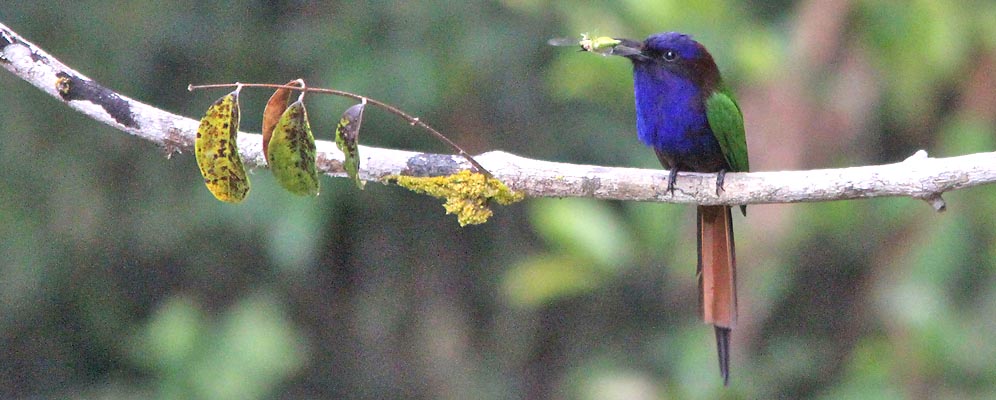 |
|||
BEE-EATERS Meropidae |
|||
|
|||
Many bee-eaters, including both Carmine species, are social birds breeding in colonies on river banks and foraging out over open country. They are attracted to bush fires and hawk around the edges; their Mandinka name (in The Gambia) means "cousin to the fire" (Fry 1984). This nugget comes from the two very fine books on bee-eaters by C. Hillary Fry (Fry 1988, Fry et al. 1992), a Brit who has spent substantial time studying them in Africa and the Middle East. His first book nicely summarizes the family this way:
|
|||
|
|||
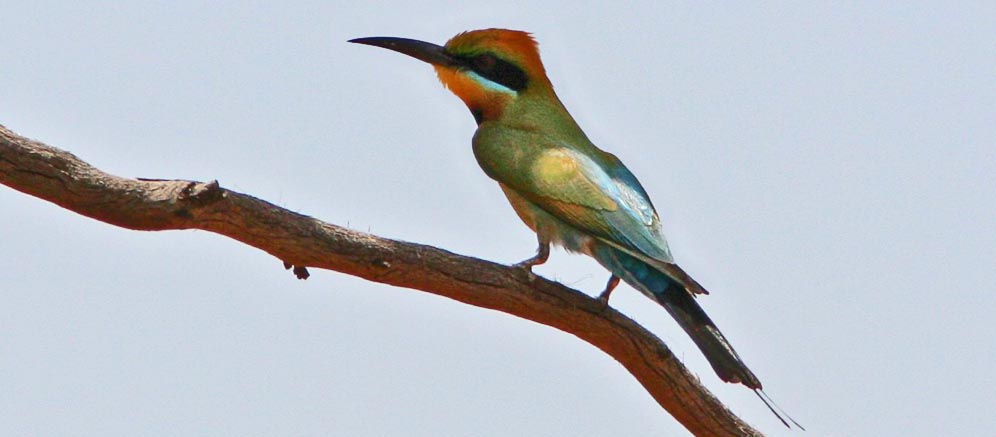 |
|||
|
Bee-eaters eat bees. While they will pursue all types of flying insects, honeybees predominate their diet. Indeed, the world range of the bee-eaters is nearly congruent to the native world range of the four species of honeybees. Fry et al. (1992) says that "in 20 separate studies of the diet of 16 kinds of bee-eaters, Hymenoptera (ants, bees and wasps) comprised from 20% to 96% of all insects eaten, and honeybees formed on average about one-third of the Hymenoptera... [this all] suggests that for eons the birds have evolved in relations to honeybees, as their predators." All venomous bees and wasps that are caught on the wing are brought back to the perch where they are devenomed (by violent bouts of pounding and rubbing), immobilized and eaten. Furthermore, bee-eaters are programmed to catch things on the wing. Once an insect lands the bee-eater ignores it, even if in plain sight. |
|||
|
|||
| My favorite bee-eaters are those restricted to dense rainforest: three in Africa and three in Asia. Two beautiful examples from west and central Africa are Black Bee-eater (below left) and Blue-moustached Bee-eater (below right). The latter species is a recent split from Blue-headed Bee-eater Merops muelleri — Blue-moustached is the west African endemic and Blue-headed is in central Africa from Cameroon through the Congo basin. All have striking red throats contrasting with a dark blue or black body plumage. They can be difficult to locate as they sit quietly in canopy or sub-canopy, alone or in pairs, until a bout of foraging is a movement noticed by an observer. These canopy species often a return to the same perch after fly-catching. | |||
|
|||
|
|||
My three favorite species from Asia are also secretive forest birds, and none of them are in the genus Merops. Two species in the genus Nyctornis: Red-bearded Bee-eater of Peninsular Malaysia, Sumatra and Borneo (above left) and the more northern Blue-bearded Bee-eater (above right; a very nice digiscope from Thailand by Joe Morlan). Add to these the spectacular Sulawesi endemic, Purple-bearded Bee-eater in the genus Meropogon — shown in the headline photo at the top of this page — and you have a glorious set of forest birds. Some of these, like Blue-bearded Bee-eater, are typically seen only high in the canopy. Morlan's nice photo is from a fruiting tree. All these species — indeed, all bee-eaters of all genera — dig burrows in soft earthen banks as nesting sites. My encounters with Red-bearded Bee-eater on Sumatra and the Malay Peninsula have been near such nest sites, and at ground level.
Although the forest-dwelling bee-eaters are mostly resident, many species of Merops bee-eater are migratory, including the European Bee-eater M. apiaster that travels thousands of miles from European breeding grounds to west and southern Africa. The now-split populations of Northern Carmine Bee-eater M. numbicus and Southern Carmine Bee-eater M. nubicoides are intra-African migrants. These two populations never come in contact with the Northern birds breeding in the savanna woodlands just south of the Sahara while the Southern birds breed in open dry country in interior southern Africa. Both then move substantial distances towards the equator, but ranges do not overlap. Fry (1984) believed these populations were separated by the last ice age and have been allopatric for but 11,000 or so years; because they have similar behaviors his guess was that they would widely interbreed if environmental change brought them back together again. On the other hand, given the recent work with Galapagos finches which illustrates how rapidly taxa can evolve, 11000+ years seems like plenty of time for isolating mechanisms to have evolved, and the now-generally-accepted interpretation is to split the two populations as species. In Australasia, Rainbow Bee-eater (another photo below) has a significant migration. This photo also illustrates another feature shared by numerous species. When the wings are closed, the remiges are hidden. But inflight flght the (usually) chestntut primaries and secondaries appear as a very colorful wing-patch. |
|||
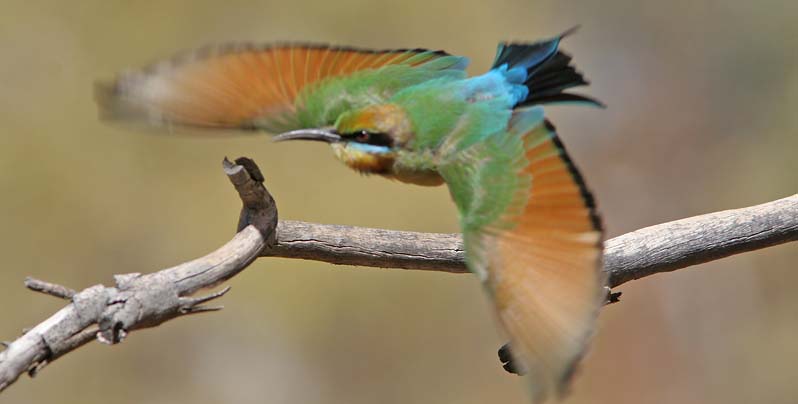 |
|||
|
|||
Photos: The Purple-bearded Bee-eater Meropogon forsteni was high up the Anaso track, Lore Lindu NP, Sulawesi, Indonesia, on 11 Sep 2011. Greg W. Lasley took the perched group of Southern Carmine Bee-eater Merops nubicoides in Okavango Delta, Botswana, on 16 Nov 1981. The Rosy Bee-eater M. malimbicus was at Abrafo, Ghana, on 4 Dec 2013. The Little Bee-eater M. pusillus was at Tarangire NP, Tanzania, on 5 Aug 2002. The pair of Swallow-tailed Bee-eater M. hirundineus was in the Kalahari-Gemsbok Reserve, South Africa, in July 2005. The White-throated Bee-eater M. albicollis was at Atewa, Ghana, on 19 Dec 2013. The Black Bee-eater M. gularis was in the Nsutu Forest, Ghana, on 5 Dec 2013. The Blue-moustached Bee-eater M. gularis was in the Opra Forest, Ghana, on 13 Dec 2013. The Red-bearded Bee-eater Nyctornis amictus was in the Panti Forest, Peninsular Malaysia, on 24 Sep 2011. Joe Morlan digiscoped the Blue-bearded Bee-eater N. athertoni at Kaeng Krachan NP, Thailand, on 9 Jan 2013. The evening roost of Chestnut-headed Bee-eater M. leschenaulti was at Kaeng Krachan NP, Thailand, on 21 Dec 2012. The flight photo of Rainbow Bee-eater M. ornatus was at Serpentine Gorge in central Australia on 17 Aug 2008. The photos of Red-throated Bee-eater M. bullocki were both from at Mole NP, Ghana, in Dec 2013. David Bishop photographed the perched pair; I took the earrly morning huddle by digiscope. Photos © Don Roberson, except those attributed to Greg W. Lasley, Joe Morlan, and K. David Bishop who hold those copyrights and used with permission; all rights reserved. Family book:
Literature cited:
|
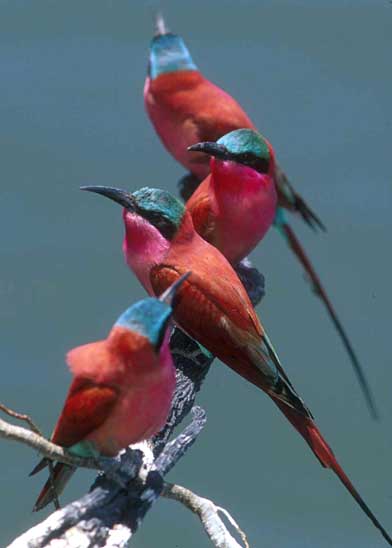 Bee-eaters
rank among the most delightful birds on Earth. They possess startling
grace and beauty, well exemplified by the endemic Purple-bearded Bee-eater of Sulawesi (above) or by these Southern Carmine Bee-eaters
in the Okavango Delta of Botswana in southern Africa (left in a lovely
shot by Greg Lasley). My wife Rita Carratello considers bee-eaters to
be her favorite bird family (see photo of her license plate, below).
Bee-eaters
rank among the most delightful birds on Earth. They possess startling
grace and beauty, well exemplified by the endemic Purple-bearded Bee-eater of Sulawesi (above) or by these Southern Carmine Bee-eaters
in the Okavango Delta of Botswana in southern Africa (left in a lovely
shot by Greg Lasley). My wife Rita Carratello considers bee-eaters to
be her favorite bird family (see photo of her license plate, below). 
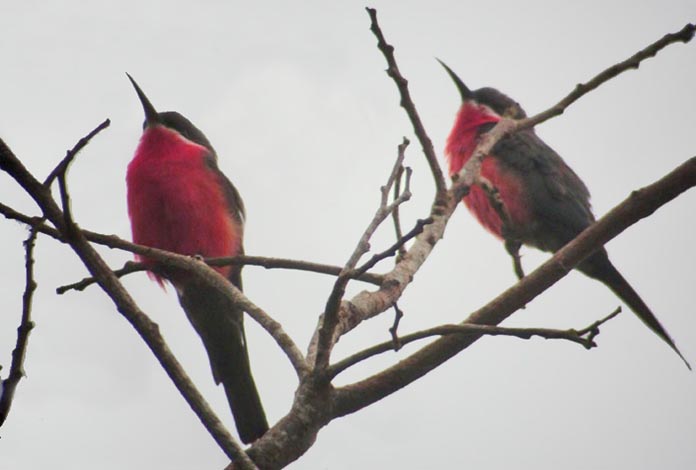
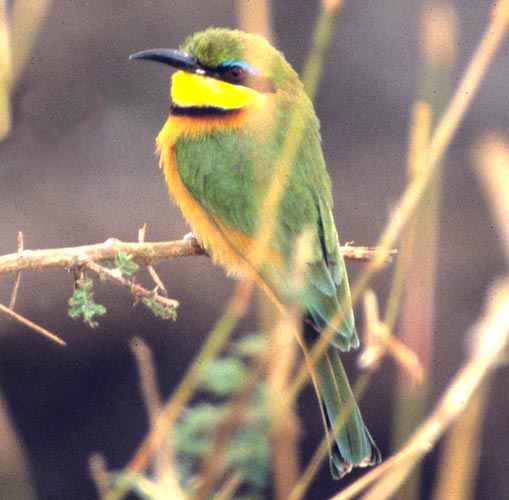 Most bee-eaters are in the genus Merops. A fair number — like Rainbow Bee-eater
(above) — are migratory; the "Rainbow bird" of Australia moves north to
New Guinea and the Moluccas after nesting. African breeders include
residents and intra-African migrants. Shown here are Little Bee-eater (right); Swallow-tailed Bee-eater (below left); and White-throated Bee-eater (below right). These are all species of rather open habitats. Little Bee-eater is widespread and may be the most numerous of all bee-eaters. Swallow-tailed Bee-eater
has a wide range in Africa, but it is much more patchy in occurrence
than Little, preferring savanna woodland with park-like and/or
semi-desert characteristics (the photo is from the edge of the Kalahari
Desert). White-throated Bee-eater breeds in a narrow
band of sub-desert steppe along the southern edge of the Sahara, and
then migrates south to humid tropical rainforests of west and central
Africa for the non-breeding season.
Most bee-eaters are in the genus Merops. A fair number — like Rainbow Bee-eater
(above) — are migratory; the "Rainbow bird" of Australia moves north to
New Guinea and the Moluccas after nesting. African breeders include
residents and intra-African migrants. Shown here are Little Bee-eater (right); Swallow-tailed Bee-eater (below left); and White-throated Bee-eater (below right). These are all species of rather open habitats. Little Bee-eater is widespread and may be the most numerous of all bee-eaters. Swallow-tailed Bee-eater
has a wide range in Africa, but it is much more patchy in occurrence
than Little, preferring savanna woodland with park-like and/or
semi-desert characteristics (the photo is from the edge of the Kalahari
Desert). White-throated Bee-eater breeds in a narrow
band of sub-desert steppe along the southern edge of the Sahara, and
then migrates south to humid tropical rainforests of west and central
Africa for the non-breeding season. 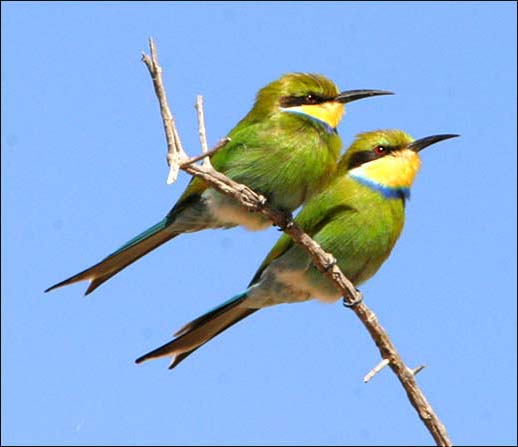
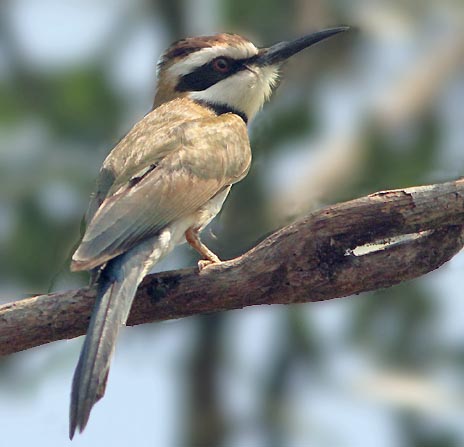




 Tropical southeast Asia also has a fine diversity of Merops bee-eaters, including the Chestnut-headed Bee-eater, shown here (right) as they gather at an evening roost in Thailand.
Tropical southeast Asia also has a fine diversity of Merops bee-eaters, including the Chestnut-headed Bee-eater, shown here (right) as they gather at an evening roost in Thailand.  Their
colorful plumage, engaging fly-catching behaviors, hidden wing flashes
and (for some) tail streamers are all reasons that bee-eaters are
popular. Yet another beautiful species is Red-throated Bee-eater
(left, a lovely shot by David Bishop). Yet another engaging behavior of
this species is a tendency to huddle together at night roosts. Here's
my digiscoped shot of an early morning roost in Ghana (below).
Their
colorful plumage, engaging fly-catching behaviors, hidden wing flashes
and (for some) tail streamers are all reasons that bee-eaters are
popular. Yet another beautiful species is Red-throated Bee-eater
(left, a lovely shot by David Bishop). Yet another engaging behavior of
this species is a tendency to huddle together at night roosts. Here's
my digiscoped shot of an early morning roost in Ghana (below). 
